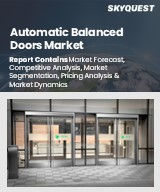
|
시장보고서
상품코드
1771113
자동문 시장 : 세계 산업 규모, 점유율, 동향, 기회, 예측 - 부문별, 유형별, 최종사용자별, 기능별, 지역별, 경쟁별(2020-2030년)Automatic Doors Market - Global Industry Size, Share, Trends, Opportunity, and Forecast, Segmented, By Type, By End-User, By Function, By Region, By Competition, 2020-2030F |
||||||
세계의 자동문 시장 규모는 2024년에 259억 1,000만 달러, 2030년에는 401억 달러에 달하며, CAGR 7.39%로 성장할 것으로 예측됩니다.
이 시장은 모션 센서, 출입관리 시스템, 원격 제어, 생체인식 솔루션 등의 기술을 이용한 자동 개폐 도어의 설계, 제조, 유통, 설치를 포괄하고 있습니다. 자동문은 편리성, 위생성, 에너지 효율, 안전성을 향상시켜 복합 상업시설, 병원, 쇼핑센터, 공항, 호텔, 산업 플랜트, 현대식 주택 등에 널리 채택되고 있습니다. 스마트 시스템과의 통합은 원활한 운영을 지원하며, 빌딩 자동화 및 커넥티드 인프라를 중시하는 세계의 흐름에 부합합니다.
| 시장 개요 | |
|---|---|
| 예측 기간 | 2026-2030년 |
| 시장 규모 : 2024년 | 259억 1,000만 달러 |
| 시장 규모 : 2030년 | 401억 달러 |
| CAGR : 2025-2030년 | 7.39% |
| 급성장 부문 | 스윙 |
| 최대 시장 | 북미 |
시장 성장 촉진요인
스마트 인프라 및 빌딩 자동화에 대한 수요 증가
주요 시장 이슈
높은 초기 투자 및 도입 비용
주요 시장 동향
자동문에 스마트 기술 통합 증가
목차
제1장 개요
제2장 조사 방법
제3장 개요
제4장 고객의 소리
제5장 세계의 자동문 시장 전망
- 시장 규모·예측
- 금액별
- 시장 점유율·예측
- 유형별(슬라이드식, 스윙식, 접이식 등)
- 최종사용자별(상업, 산업, 주택)
- 기능별(센서 기반, 모션 기반, 푸시 버튼, 액세스 제어)
- 지역별
- 기업별(2024년)
- 시장 맵
제6장 북미의 자동문 시장 전망
- 시장 규모·예측
- 시장 점유율·예측
- 북미 : 국가별 분석
- 미국
- 캐나다
- 멕시코
제7장 유럽의 자동문 시장 전망
- 시장 규모·예측
- 시장 점유율·예측
- 유럽 : 국가별 분석
- 독일
- 영국
- 이탈리아
- 프랑스
- 스페인
제8장 아시아태평양의 자동문 시장 전망
- 시장 규모·예측
- 시장 점유율·예측
- 아시아태평양 : 국가별 분석
- 중국
- 인도
- 일본
- 한국
- 호주
제9장 남미의 자동문 시장 전망
- 시장 규모·예측
- 시장 점유율·예측
- 남미 : 국가별 분석
- 브라질
- 아르헨티나
- 콜롬비아
제10장 중동 및 아프리카의 자동문 시장 전망
- 시장 규모·예측
- 시장 점유율·예측
- 중동 및 아프리카 : 국가별 분석
- 남아프리카공화국
- 사우디아라비아
- 아랍에미리트
- 쿠웨이트
- 튀르키예
제11장 시장 역학
- 촉진요인
- 과제
제12장 시장 동향과 발전
- 합병과 인수
- 제품 출시
- 최근 동향
제13장 기업 개요
- ASSA ABLOY AB
- dormakaba Holding AG
- GEZE GmbH
- Stanley Access Technologies LLC
- Nabtesco Corporation
- Horton Automatics
- Deutschtec GmbH
- Record Doors(Agta Record Ltd)
- Panasonic Corporation
- TORMAX USA Inc.
제14장 전략적 제안
제15장 조사회사 소개·면책사항
KSA 25.07.22The Global Automatic Doors Market was valued at USD 25.91 Billion in 2024 and is projected to reach USD 40.10 Billion by 2030, growing at a CAGR of 7.39%. The market encompasses the design, production, distribution, and installation of doors that open and close automatically using technologies such as motion sensors, access control systems, remote controls, and biometric solutions. Automatic doors provide enhanced convenience, hygiene, energy efficiency, and security, making them widely adopted in commercial complexes, hospitals, shopping centers, airports, hotels, industrial plants, and modern residential properties. Their integration with smart systems supports seamless operations and aligns with the growing global emphasis on building automation and connected infrastructure.
| Market Overview | |
|---|---|
| Forecast Period | 2026-2030 |
| Market Size 2024 | USD 25.91 Billion |
| Market Size 2030 | USD 40.10 Billion |
| CAGR 2025-2030 | 7.39% |
| Fastest Growing Segment | Swinging |
| Largest Market | North America |
Key Market Drivers
Rising Demand for Smart Infrastructure and Building Automation
The global shift toward smart infrastructure and automated building systems is significantly accelerating the adoption of automatic doors. As cities and buildings become more intelligent and interconnected, the need for advanced access solutions that contribute to energy efficiency, operational convenience, and occupant safety has surged. Automatic doors equipped with smart sensors, access control systems, and IoT-based capabilities fit seamlessly into these ecosystems, streamlining entry and exit while maintaining controlled indoor environments.
This trend is particularly strong in airports, malls, hospitals, and office buildings where managing foot traffic efficiently and hygienically is critical. The integration of automatic doors with building management systems enables real-time control, usage tracking, and predictive maintenance. In high-income nations and emerging smart cities, increased investments in sustainable, efficient building infrastructure further support the expansion of the automatic doors market. Their contribution to energy conservation through controlled airflow also helps buildings comply with green standards and energy codes.
Key Market Challenges
High Initial Investment and Installation Costs
A major challenge for the Automatic Doors Market lies in the significant upfront investment required for procurement and installation. These systems incorporate advanced components such as sensors, actuators, and control panels that demand precision integration and specialized labor. The costs can be especially burdensome for small businesses or projects with budget constraints.
Retrofitting older buildings with automatic doors often necessitates architectural modifications, further increasing expenses. For spaces with limited installation areas or complex design layouts, customized solutions drive costs higher. Beyond initial setup, buyers must also factor in ongoing operational costs including regular maintenance, calibration, software updates, and component replacements, all of which require skilled personnel. These factors can deter adoption in price-sensitive markets or among developers who may view automatic doors as non-essential in basic construction projects. In such scenarios, manual or semi-automatic alternatives often become preferred due to their lower cost and simplicity.
Key Market Trends
Rising Integration of Smart Technologies in Automatic Doors
The integration of smart technologies is redefining the automatic doors landscape, transforming traditional systems into intelligent, responsive access solutions. With advancements in IoT, AI, and cloud connectivity, automatic doors now feature smart sensors, facial recognition systems, wireless modules, and predictive analytics. These innovations enable dynamic adjustments based on environmental conditions, foot traffic, and user behavior, while offering remote control and real-time monitoring capabilities.
Touchless operation-enabled through advanced sensors-is increasingly vital in high-footfall locations like hospitals, malls, and transit hubs, enhancing hygiene and limiting contact-based transmission. AI algorithms further optimize door operation by adjusting speed and timing according to occupancy levels and climate conditions. Integration with centralized building automation platforms allows seamless coordination of energy use, access security, and operational monitoring. In residential sectors, smart home adoption is fueling demand for connected automatic door systems that are compatible with smartphones, voice assistants, and remote applications, reinforcing the market's growth trajectory.
Key Market Players
- ASSA ABLOY AB
- dormakaba Holding AG
- GEZE GmbH
- Stanley Access Technologies LLC
- Nabtesco Corporation
- Horton Automatics
- Deutschtec GmbH
- Record Doors (Agta Record Ltd)
- Panasonic Corporation
- TORMAX USA Inc.
Report Scope:
In this report, the Global Automatic Doors Market has been segmented into the following categories, in addition to the industry trends which have also been detailed below:
Automatic Doors Market, By Type:
- Sliding
- Swinging
- Folding
- Others
Automatic Doors Market, By End-User:
- Commercial
- Industrial
- Residential
Automatic Doors Market, By Function:
- Sensor Based
- Motion Based
- Push Button
- Access Control
Automatic Doors Market, By Region:
- North America
- United States
- Canada
- Mexico
- Europe
- France
- United Kingdom
- Italy
- Germany
- Spain
- Asia-Pacific
- China
- India
- Japan
- Australia
- South Korea
- South America
- Brazil
- Argentina
- Colombia
- Middle East & Africa
- South Africa
- Saudi Arabia
- UAE
- Kuwait
- Turkey
Competitive Landscape
Company Profiles: Detailed analysis of the major companies present in the Global Automatic Doors Market.
Available Customizations:
Global Automatic Doors Market report with the given market data, Tech Sci Research offers customizations according to a company's specific needs. The following customization options are available for the report:
Company Information
- Detailed analysis and profiling of additional Market players (up to five).
Table of Contents
1. Product Overview
- 1.1. Market Definition
- 1.2. Scope of the Market
- 1.2.1. Markets Covered
- 1.2.2. Years Considered for Study
- 1.3. Key Market Segmentations
2. Research Methodology
- 2.1. Objective of the Study
- 2.2. Baseline Methodology
- 2.3. Formulation of the Scope
- 2.4. Assumptions and Limitations
- 2.5. Sources of Research
- 2.5.1. Secondary Research
- 2.5.2. Primary Research
- 2.6. Approach for the Market Study
- 2.6.1. The Bottom-Up Approach
- 2.6.2. The Top-Down Approach
- 2.7. Methodology Followed for Calculation of Market Size & Market Shares
- 2.8. Forecasting Methodology
- 2.8.1. Data Triangulation & Validation
3. Executive Summary
- 3.1. Overview of the Market
- 3.2. Overview of Key Market Segmentations
- 3.3. Overview of Key Market Players
- 3.4. Overview of Key Regions/Countries
- 3.5. Overview of Market Drivers, Challenges, and Trends
4. Voice of Customer
5. Global Automatic Doors Market Outlook
- 5.1. Market Size & Forecast
- 5.1.1. By Value
- 5.2. Market Share & Forecast
- 5.2.1. By Type (Sliding, Swinging, Folding and Others)
- 5.2.2. By End-User (Commercial, Industrial and Residential)
- 5.2.3. By Function (Sensor Based, Motion Based, Push Button, Access Control)
- 5.2.4. By Region
- 5.3. By Company (2024)
- 5.4. Market Map
6. North America Automatic Doors Market Outlook
- 6.1. Market Size & Forecast
- 6.1.1. By Value
- 6.2. Market Share & Forecast
- 6.2.1. By Type
- 6.2.2. By End-User
- 6.2.3. By Function
- 6.2.4. By Country
- 6.3. North America: Country Analysis
- 6.3.1. United States Automatic Doors Market Outlook
- 6.3.1.1. Market Size & Forecast
- 6.3.1.1.1. By Value
- 6.3.1.2. Market Share & Forecast
- 6.3.1.2.1. By Type
- 6.3.1.2.2. By End-User
- 6.3.1.2.3. By Function
- 6.3.1.1. Market Size & Forecast
- 6.3.2. Canada Automatic Doors Market Outlook
- 6.3.2.1. Market Size & Forecast
- 6.3.2.1.1. By Value
- 6.3.2.2. Market Share & Forecast
- 6.3.2.2.1. By Type
- 6.3.2.2.2. By End-User
- 6.3.2.2.3. By Function
- 6.3.2.1. Market Size & Forecast
- 6.3.3. Mexico Automatic Doors Market Outlook
- 6.3.3.1. Market Size & Forecast
- 6.3.3.1.1. By Value
- 6.3.3.2. Market Share & Forecast
- 6.3.3.2.1. By Type
- 6.3.3.2.2. By End-User
- 6.3.3.2.3. By Function
- 6.3.3.1. Market Size & Forecast
- 6.3.1. United States Automatic Doors Market Outlook
7. Europe Automatic Doors Market Outlook
- 7.1. Market Size & Forecast
- 7.1.1. By Value
- 7.2. Market Share & Forecast
- 7.2.1. By Type
- 7.2.2. By End-User
- 7.2.3. By Function
- 7.2.4. By Country
- 7.3. Europe: Country Analysis
- 7.3.1. Germany Automatic Doors Market Outlook
- 7.3.1.1. Market Size & Forecast
- 7.3.1.1.1. By Value
- 7.3.1.2. Market Share & Forecast
- 7.3.1.2.1. By Type
- 7.3.1.2.2. By End-User
- 7.3.1.2.3. By Function
- 7.3.1.1. Market Size & Forecast
- 7.3.2. United Kingdom Automatic Doors Market Outlook
- 7.3.2.1. Market Size & Forecast
- 7.3.2.1.1. By Value
- 7.3.2.2. Market Share & Forecast
- 7.3.2.2.1. By Type
- 7.3.2.2.2. By End-User
- 7.3.2.2.3. By Function
- 7.3.2.1. Market Size & Forecast
- 7.3.3. Italy Automatic Doors Market Outlook
- 7.3.3.1. Market Size & Forecast
- 7.3.3.1.1. By Value
- 7.3.3.2. Market Share & Forecast
- 7.3.3.2.1. By Type
- 7.3.3.2.2. By End-User
- 7.3.3.2.3. By Function
- 7.3.3.1. Market Size & Forecast
- 7.3.4. France Automatic Doors Market Outlook
- 7.3.4.1. Market Size & Forecast
- 7.3.4.1.1. By Value
- 7.3.4.2. Market Share & Forecast
- 7.3.4.2.1. By Type
- 7.3.4.2.2. By End-User
- 7.3.4.2.3. By Function
- 7.3.4.1. Market Size & Forecast
- 7.3.5. Spain Automatic Doors Market Outlook
- 7.3.5.1. Market Size & Forecast
- 7.3.5.1.1. By Value
- 7.3.5.2. Market Share & Forecast
- 7.3.5.2.1. By Type
- 7.3.5.2.2. By End-User
- 7.3.5.2.3. By Function
- 7.3.5.1. Market Size & Forecast
- 7.3.1. Germany Automatic Doors Market Outlook
8. Asia-Pacific Automatic Doors Market Outlook
- 8.1. Market Size & Forecast
- 8.1.1. By Value
- 8.2. Market Share & Forecast
- 8.2.1. By Type
- 8.2.2. By End-User
- 8.2.3. By Function
- 8.2.4. By Country
- 8.3. Asia-Pacific: Country Analysis
- 8.3.1. China Automatic Doors Market Outlook
- 8.3.1.1. Market Size & Forecast
- 8.3.1.1.1. By Value
- 8.3.1.2. Market Share & Forecast
- 8.3.1.2.1. By Type
- 8.3.1.2.2. By End-User
- 8.3.1.2.3. By Function
- 8.3.1.1. Market Size & Forecast
- 8.3.2. India Automatic Doors Market Outlook
- 8.3.2.1. Market Size & Forecast
- 8.3.2.1.1. By Value
- 8.3.2.2. Market Share & Forecast
- 8.3.2.2.1. By Type
- 8.3.2.2.2. By End-User
- 8.3.2.2.3. By Function
- 8.3.2.1. Market Size & Forecast
- 8.3.3. Japan Automatic Doors Market Outlook
- 8.3.3.1. Market Size & Forecast
- 8.3.3.1.1. By Value
- 8.3.3.2. Market Share & Forecast
- 8.3.3.2.1. By Type
- 8.3.3.2.2. By End-User
- 8.3.3.2.3. By Function
- 8.3.3.1. Market Size & Forecast
- 8.3.4. South Korea Automatic Doors Market Outlook
- 8.3.4.1. Market Size & Forecast
- 8.3.4.1.1. By Value
- 8.3.4.2. Market Share & Forecast
- 8.3.4.2.1. By Type
- 8.3.4.2.2. By End-User
- 8.3.4.2.3. By Function
- 8.3.4.1. Market Size & Forecast
- 8.3.5. Australia Automatic Doors Market Outlook
- 8.3.5.1. Market Size & Forecast
- 8.3.5.1.1. By Value
- 8.3.5.2. Market Share & Forecast
- 8.3.5.2.1. By Type
- 8.3.5.2.2. By End-User
- 8.3.5.2.3. By Function
- 8.3.5.1. Market Size & Forecast
- 8.3.1. China Automatic Doors Market Outlook
9. South America Automatic Doors Market Outlook
- 9.1. Market Size & Forecast
- 9.1.1. By Value
- 9.2. Market Share & Forecast
- 9.2.1. By Type
- 9.2.2. By End-User
- 9.2.3. By Function
- 9.2.4. By Country
- 9.3. South America: Country Analysis
- 9.3.1. Brazil Automatic Doors Market Outlook
- 9.3.1.1. Market Size & Forecast
- 9.3.1.1.1. By Value
- 9.3.1.2. Market Share & Forecast
- 9.3.1.2.1. By Type
- 9.3.1.2.2. By End-User
- 9.3.1.2.3. By Function
- 9.3.1.1. Market Size & Forecast
- 9.3.2. Argentina Automatic Doors Market Outlook
- 9.3.2.1. Market Size & Forecast
- 9.3.2.1.1. By Value
- 9.3.2.2. Market Share & Forecast
- 9.3.2.2.1. By Type
- 9.3.2.2.2. By End-User
- 9.3.2.2.3. By Function
- 9.3.2.1. Market Size & Forecast
- 9.3.3. Colombia Automatic Doors Market Outlook
- 9.3.3.1. Market Size & Forecast
- 9.3.3.1.1. By Value
- 9.3.3.2. Market Share & Forecast
- 9.3.3.2.1. By Type
- 9.3.3.2.2. By End-User
- 9.3.3.2.3. By Function
- 9.3.3.1. Market Size & Forecast
- 9.3.1. Brazil Automatic Doors Market Outlook
10. Middle East and Africa Automatic Doors Market Outlook
- 10.1. Market Size & Forecast
- 10.1.1. By Value
- 10.2. Market Share & Forecast
- 10.2.1. By Type
- 10.2.2. By End-User
- 10.2.3. By Function
- 10.2.4. By Country
- 10.3. Middle East and Africa: Country Analysis
- 10.3.1. South Africa Automatic Doors Market Outlook
- 10.3.1.1. Market Size & Forecast
- 10.3.1.1.1. By Value
- 10.3.1.2. Market Share & Forecast
- 10.3.1.2.1. By Type
- 10.3.1.2.2. By End-User
- 10.3.1.2.3. By Function
- 10.3.1.1. Market Size & Forecast
- 10.3.2. Saudi Arabia Automatic Doors Market Outlook
- 10.3.2.1. Market Size & Forecast
- 10.3.2.1.1. By Value
- 10.3.2.2. Market Share & Forecast
- 10.3.2.2.1. By Type
- 10.3.2.2.2. By End-User
- 10.3.2.2.3. By Function
- 10.3.2.1. Market Size & Forecast
- 10.3.3. UAE Automatic Doors Market Outlook
- 10.3.3.1. Market Size & Forecast
- 10.3.3.1.1. By Value
- 10.3.3.2. Market Share & Forecast
- 10.3.3.2.1. By Type
- 10.3.3.2.2. By End-User
- 10.3.3.2.3. By Function
- 10.3.3.1. Market Size & Forecast
- 10.3.4. Kuwait Automatic Doors Market Outlook
- 10.3.4.1. Market Size & Forecast
- 10.3.4.1.1. By Value
- 10.3.4.2. Market Share & Forecast
- 10.3.4.2.1. By Type
- 10.3.4.2.2. By End-User
- 10.3.4.2.3. By Function
- 10.3.4.1. Market Size & Forecast
- 10.3.5. Turkey Automatic Doors Market Outlook
- 10.3.5.1. Market Size & Forecast
- 10.3.5.1.1. By Value
- 10.3.5.2. Market Share & Forecast
- 10.3.5.2.1. By Type
- 10.3.5.2.2. By End-User
- 10.3.5.2.3. By Function
- 10.3.5.1. Market Size & Forecast
- 10.3.1. South Africa Automatic Doors Market Outlook
11. Market Dynamics
- 11.1. Drivers
- 11.2. Challenges
12. Market Trends & Developments
- 12.1. Merger & Acquisition (If Any)
- 12.2. Product Launches (If Any)
- 12.3. Recent Developments
13. Company Profiles
- 13.1. ASSA ABLOY AB
- 13.1.1. Business Overview
- 13.1.2. Key Revenue and Financials
- 13.1.3. Recent Developments
- 13.1.4. Key Personnel/Key Contact Person
- 13.1.5. Key Product/Services Offered
- 13.2. dormakaba Holding AG
- 13.3. GEZE GmbH
- 13.4. Stanley Access Technologies LLC
- 13.5. Nabtesco Corporation
- 13.6. Horton Automatics
- 13.7. Deutschtec GmbH
- 13.8. Record Doors (Agta Record Ltd)
- 13.9. Panasonic Corporation
- 13.10. TORMAX USA Inc.
14. Strategic Recommendations
15. About Us & Disclaimer
(주말 및 공휴일 제외)


















